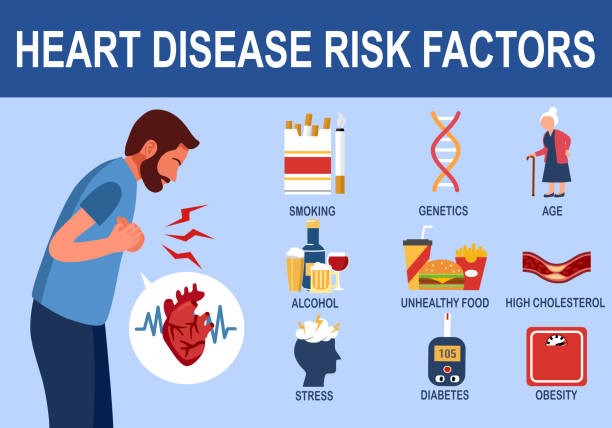Health Conditions
Shocking Truths About Heart Disease
Heart disease, also known as cardiovascular disease, is a major cause of death worldwide and a global health problem. It includes a variety of illnesses that impact the structure and operation of the heart. It is essential for healthcare providers to give people the information they need to manage this illness. This entails being aware of its risk factors, identifying its symptoms, and putting preventative measures into action. This article attempts to inspire readers to take proactive steps to protect their heart health by giving a thorough review of heart disease.
Section 1: What is Heart Disease?
Heart disease is a broad category of disorders that affect the anatomy and function of the heart in combination. Heart failure, arrhythmias, valvular heart disease, and coronary artery disease are a few of these disorders that might present with different symptoms and difficulties. Effective prevention and management of these disorders need a thorough understanding of their subtleties.
For example, coronary artery disease causes the blood arteries that feed the heart muscle with oxygen and nutrients to constrict, which may result in heart attacks or chest discomfort. Contrarily, heart failure is characterized by the heart’s decreased capacity to pump blood, which leads to symptoms including exhaustion and dyspnea. Unusual cardiac rhythms, or arrhythmias, can cause palpitations and vertigo. Breathlessness and chest discomfort are among the symptoms of valve disease, which is a disorder affecting the heart’s valves.
Understanding the unique characteristics of these illnesses allows patients and healthcare professionals to collaborate in the implementation of focused preventative and treatment methods, which will eventually improve heart health and general well-being. People who possess this knowledge are better able to make educated decisions and navigate their own cardiovascular health path with confidence.
Section 2: Risk Factors
A. Modifiable Risk Factors:
High Blood Pressure (Hypertension) – increases the risk of heart disease and its consequences by placing additional strain on the heart and blood arteries.
High Cholesterol Levels – High blood cholesterol can cause fatty deposits to accumulate in the arteries, constricting them and possibly resulting in heart-related problems.
Smoking – Because tobacco use, especially smoking, damages blood vessels, lowers oxygen levels, and encourages plaque accumulation, it greatly increases the risk of heart disease.
Poor Diet and Lack of Exercise – Sedentary lifestyles and unhealthy eating patterns raise blood pressure, cholesterol, and weight gain—all of which are significant risk factors for heart disease.
Obesity – Being overweight greatly raises the risk of heart-related issues, especially when combined with other risk factors like diabetes and high blood pressure.
Diabetes – If left unchecked or poorly managed, elevated blood sugar levels can damage blood vessels over time and raise the risk of heart disease.
Stress and Mental Health – By altering behaviors (such as bad coping techniques) and physiological variables (such as increased blood pressure), chronic stress and mental health disorders can raise the risk of heart disease.
B. Non-Modifiable Risk Factors:
Age – People are more naturally at risk of having heart disease as they age. The heart and blood arteries may alter as a person ages, rendering them more vulnerable to certain cardiovascular diseases.
Gender – The risk profiles for heart disease may differ between men and women. For instance, women’s risk increases after menopause, but men’s risk tends to increase earlier in life.
Family History – You may be more likely to acquire comparable diseases if you have close relatives with a history of heart disease, such as parents or siblings. This implies that there could be a hereditary propensity.
Ethnicity – People from particular ethnic origins may be more vulnerable to certain heart-related illnesses. People of African, South Asian, or Hispanic heritage, for example, may be more susceptible to certain cardiovascular problems.

Section 3: Signs and Symptoms Recognizing the signs
Common symptoms may include:
Chest Pain or Discomfort
Shortness of Breath
Fatigue
Irregular Heartbeat
Swelling in the Legs, Ankles, and Feet
Section 4: Diagnostic Procedures
Electrocardiogram (ECG or EKG) – This non-invasive test measures the electrical activity of the heart and provides details on its rhythm, pace, and any anomalies.
Echocardiogram – This imaging test makes a precise image of the anatomy and physiology of the heart using sound waves, which enables medical professionals to evaluate the heart’s pumping capability and identify any anomalies.
Stress Test – Usually performed on a stationary bike or treadmill, a stress test measures the heart’s reaction to physical activity. This aids in assessing blood flow and any possible heart disease symptoms when under pressure.
Cardiac Catheterization – This invasive technique entails threading a tiny tube, called a catheter, up to the heart by inserting it into a blood artery, generally in the wrist or groin. It makes it possible to monitor the pressure inside the heart chambers and to image them in great detail.
Blood Tests (for cardiac enzymes and biomarkers) – These examinations look for particular chemicals in the blood that may be signs of damage to the heart muscle. Increased concentrations of specific enzymes and biomarkers might indicate a heart-related problem, including a heart attack.
Section 5: Treatment Options
Lifestyle Modifications (Diet, Exercise, Smoking Cessation) – A key component of managing heart disease is implementing healthy lifestyle modifications. This includes giving up smoking, starting an exercise regimen, and eating a heart-healthy diet—all of which improve heart health.
Medications (for blood pressure, cholesterol, etc.) – Different drugs are recommended to treat different elements of heart disease. These might include medications for heart rhythm regulation, blood pressure management, cholesterol reduction, and other cardiovascular issues.
Interventional Procedures (Angioplasty, Stenting) – These minimally invasive techniques are used to open blocked or constricted arteries and restore blood flow. While stenting entails inserting a mesh tube to keep the artery open, angioplasty entails expanding the artery by inflating a balloon inside it.
Surgery (Bypass Surgery, Valve Replacement) – More involved procedures may be needed in some situations. Bypass surgery reroutes blood flow around clogged arteries, whereas valve replacement replaces malfunctioning or diseased heart valves with biological or artificial valves. A skilled surgical team performs these surgeries in a hospital environment.

Section 6: Lifestyle Changes
Heart-Healthy Diet – Eating a varied, nutrient-rich diet is essential to developing a heart-healthy diet. The consumption of saturated and trans fats, salt, added sugars, and whole grains is minimized in favor of fruits, vegetables, lean proteins, and healthy fats. This food plan helps to maintain heart health by encouraging blood pressure, cholesterol, and cardiovascular health at its best.
Regular Exercise – To keep your heart healthy, you must exercise on a regular basis. This consists of a mix of strength training, flexibility training, and aerobic workouts (such running, walking, or swimming). Frequent exercise enhances blood circulation, improves cardiovascular fitness, and benefits general wellbeing.
Stress Management Techniques – Heart health depends on stress management done well. Methods like yoga, mindfulness exercises, deep breathing, and meditation can help lower blood pressure, ease tension, and encourage relaxation.
Smoking Cessation and Alcohol Moderation – Reducing alcohol intake and giving up smoking are essential steps toward heart health. Giving up smoking can improve cardiovascular health both now and in the future. Smoking is a major risk factor for heart disease. In a similar vein, moderate alcohol use promotes heart health by lowering the chance of associated problems.
Section 7: Prevention Strategies
Regular Health Check-ups and Screenings – For the early identification and treatment of heart disease risk factors, routine health examinations and screenings are crucial. During these visits, medical professionals may check blood pressure, cholesterol, and cardiovascular health in general, giving them the chance to take preventative and intervention measures in good time.
Knowing Family History and Genetics – Proactive prevention requires knowledge of one’s family history of heart disease as well as any possible genetic predispositions. With this information, people may identify the risks specific to them and take the necessary precautions to lessen any worries.
Monitoring Blood Pressure and Cholesterol Levels – One of the most important ways to avoid heart disease is to regularly monitor blood pressure and cholesterol levels. Heart-related problems can be greatly decreased by maintaining these indicators within safe limits by lifestyle changes and, if needed, medical procedures.
Creating a Personalized Risk Reduction Plan – One proactive step toward heart health is working with healthcare experts to create a customized risk reduction strategy. Based on each person’s unique risk factors and health state, this plan may include targeted treatments, medication management, and food and activity advice. Adhering to a customized plan guarantees a targeted and successful strategy for heart disease prevention.
Understanding heart disease is like having a reliable map for a heart-healthy journey. It’s not about drastic changes, but small, sustainable shifts in our daily habits. Like choosing wholesome foods, taking time for a brisk walk, and managing stress. And when we have a concern, seeking help early is like a timely pit stop, ensuring our heart’s engine runs smoothly. These steps aren’t just about avoiding heart disease; they’re about living a fuller, richer life with the people we love. It’s like giving our hearts the best care possible, so they can keep beating strong for years to come.


